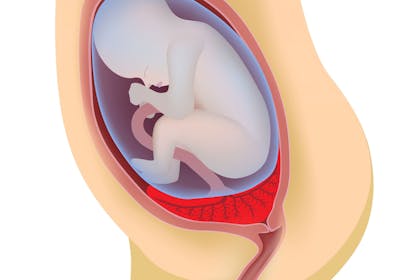Placenta praevia (sometimes spelled placenta previa) is when your placenta stays low in your womb during pregnancy, near to or actually covering your cervix. It can cause light or heavy bleeding and affects labour and birth as you may need to have a C-section to get the baby out.
This page contains affiliate links, which means we may earn a small amount of money if a reader clicks through and makes a purchase. All our articles and reviews are written independently by the Netmums editorial team.
What's a low-lying placenta?
During your 20 week anomaly scan , the sonographer will be checking to see where in your uterus the placenta is growing.
If it's developing in the lower part, where it could block the opening of your womb opening, it's referred to as a low-lying placenta.
This is fairly common – affecting around 1 in 20 pregnancies, according to the NHS – and it doesn't necessarily mean you have the condition referred to as placenta praevia.
FREE NEWBORN NAPPIES
That's because in about 90% of cases, this low-lying placenta shifts into the upper segment of your uterus by the time your baby's ready to be born, and doesn't cause any complications.
What's placenta praevia?
If your scan detects a low-lying placenta, you'll be asked to return for another scan at 32 weeks. If it's still attached to the lower part of the uterus (womb), this is what's called placenta praevia.
In some cases, a transvaginal scan (an internal scan using a probe in your vagina) may be used, as this can be more accurate.
According to the NHS, placenta praevia affects about 1 in 200 pregnancies and you'll be made aware of the signs and symptoms it can cause (see below) and will most likely be recommended you give birth by C-section .
Placenta praevia: the signs and symptoms
Placenta praevia can cause vaginal bleeding during pregnancy, usually in the last three months of your pregnancy, often between weeks 24-28.
This is caused by your uterus growing and stretching and causing the placenta to separate from the wall.
Although placenta praevia is usually picked up by a scan before this, contact your GP or midwife straight away if you experience bleeding during pregnancy .
Placenta praevia can also cause your baby to lie in an unusual position, such as breech or transverse.
If your midwife suspects you have a low-lying placenta at any point in your pregnancy, she'll usually suggest a scan to confirm whether this is the case.
Placenta praevia: what are the risks?
If you've been diagnosed with placenta praevia, the main risk to you and your baby is bleeding during the second half of your pregnancy. This is usually bright red blood with no associated pain.
Bleeding little and often can cause anaemia while shorter sharper bursts of heavy bleeding can cause fainting and low blood pressure.
Depending on the grade of your placenta praevia (see below) it can also block your baby's exit from the womb making it likely you'll need to have a C-section to get her out.
Placenta praevia: what's the treatment?
There are four different grades of placenta praevia, and treatment varies depending on which grade you have:
- Grade one: the majority of your placenta is in the upper segment of your uterus, but some extends to the lower part.
- Grade two: the placenta is partially located in the lower segment and reaches the cervix, but doesn't cover it.
- Grade three: the placenta partially covers the cervix.
- Grade four: the placenta completely covers the cervix, also referred to as major placenta praevia.
If you've been diagnosed with grade one or two placenta praevia, there's usually no need for treatment. You'll be closely monitored in case there's any bleeding, but you should be able to have a vaginal birth.
If you have been diagnosed with grade three or four placenta praevia, you'll be advised to have a planned C-section, as the placenta is in the way of your baby being born.
How early this is booked in for will depend on your symptoms and how much blood you're losing. With monitoring and provided there's not too much blood loss, you should be able to go up until week 37-38.
However, you may also be admitted to hospital in the final few weeks of pregnancy, as there's a small risk that you could bleed suddenly and severely and need an urgent C-section.
What to expect after a placenta praevia C-section
After your C-section, it's possible that you'll lose more blood than after a standard C-section. It's also quite common to pass clots in the first few hours after giving birth.
You'll be closely monitored and put on a hormone drip that'll help minimise bleeding. If you lose a lot of blood you'll need to have a blood transfusion.







